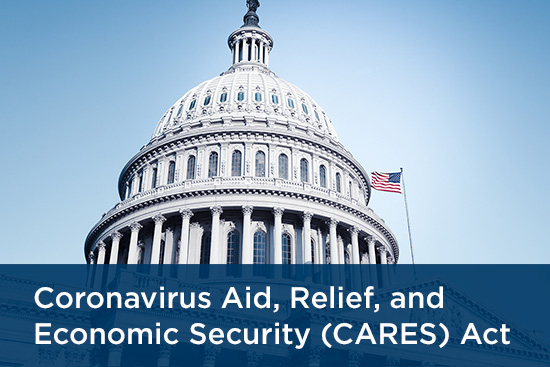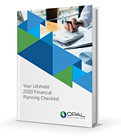What the New Coronavirus Relief Bill Means for Your Finances
By Lee Korn & Jesse Giordano, CFP® | March 28, 2020No matter where you live or what you do for a living, we’re all feeling the economic impact from the coronavirus. In fact, close to 3.3 million American workers recently filed for unemployment benefits.
With that being said, there is a light at the end of the tunnel. President Trump has signed the Coronavirus Aid, Relief and Economic Security (CARES) Act into law—which means that some much-needed relief is on its way. Before we unpack how the $2 trillion aid package will affect you, it’s worth calling out some other economic benefits that are also on the table right now for many Americans.

The deadline to file and pay your 2019 federal tax return has officially been pushed from April 15thto July 15th, giving folks a little more time to get their affairs in order with Uncle Sam. Businesses and self-employed individuals are getting an extra tax cushion and will not have to make their first estimated quarterly tax payment until that time.
On the job front, workers impacted by the coronavirus will now receive two weeks paid sick leave. FYI, companies with more than 500 employees are exempt, as are health care providers. Small businesses with fewer than 50 employees are also off the hook if paying these benefits would threaten to put them under. Either way, companies that do participate can offset some of the costs with tax credits. Similarly, self-employed individuals are eligible for the benefit by way of a tax credit.
More sweeping changes are in store. Here’s a closer look at the details that will have an impact on your finances.
Relief Checks Are Headed to Most Households
This part of the package is getting a lot of airtime because it translates to cash in hand for most families. Those who earn less than $75,000 will receive a $1,200 check. That number bumps up to $2,400 for married couples filing jointly who earn up to $150,000. On top of that, the government will be providing an additional $500 for each child in the household. This amount gradually phases out for those who earn more. Individuals whose earnings exceed $99,000 ($198,000 for joint filers) are ineligible for relief checks.
The amount you receive will be based on your 2019 tax return; 2018 if that’s the most recent information available. According to the Trump administration, checks should be going out within three weeks.
Folks who have federal student loans will also be able to defer their payments through September 30th. During this time, no interest will accrue on this debt. Involuntary collection of student loans will also stop through the end of September.
Unemployment Benefits Are Expanding
The government is responding to the fact that there’s been a major influx in the number of Americans applying for unemployment benefits. Per the new legislation, previously ineligible folks will now be covered. This includes freelancers. Another notable detail is that it provides an extra 13 weeks of unemployment insurance.
People can also expect bigger unemployment checks—an extra $600 per week for up to four months. A number of factors, including where you live and your prior wages, will determine the total amount you could receive. No matter what, the benefits max out after 39 weeks.
There Are Some Changes Coming to Your Retirement Accounts
Those who are forced to take distributions from their retirement accounts of up to $100,000 because of the coronavirus will not be hit with a 10% early withdrawal penalty, thanks to the CARES Act. Regular mandatory withholding requirements are out of the picture, as well. They’ll also have the option to spread the tax bill for these distributions out over three years—and have the green light to recontribute back to those accounts in the future if they want to eventually play catch-up. Another available option is to split the distribution itself evenly over a three-year period, but elect to include the total amount as part of their 2020 income.
Another big detail of the CARES Act is that Required Minimum Distributions (RMDs) for this year have been suspended. (You normally have to begin taking distributions from tax-advantaged retirement accounts beginning at age 72, or 70 ½ if you reach 70 ½ before January 1, 2020.)
Loans from retirement accounts have been doubled from $50,000 to a maximum of $100,000, and 100% of the vested balance may be used. Any payments that are owed on the plan loan may be delayed for up to one year.
News About Charitable Donations
There’s a new $300 deduction for qualified charitable donations. This is an above-the-line deduction, so you don’t have to itemize your deductions to receive this benefit. In other words, you can write off up to $300 in cash donations made to non-profit organizations.
How It Impacts Your Health Care Expenses
Qualified medical expenses for HSA and FSA accounts have been expanded to include over-the-counter medications and menstrual products as part of the CARES Act. Medicare beneficiaries will be eligible to receive the COVID-19 vaccine (when available) at no cost. During the COVID-19 emergency period, Medicare Part D recipients must be given the ability to have, upon request, up to a 90-day supply of medication prescribed and filled.
Businesses Will Have Access to Loan Programs and Aid
The coronavirus is bringing many companies to their knees. The new legislation earmarks hundreds of billions to help keep small businesses afloat during this time. Businesses that have fewer than 500 employees (including non-profits and self-employed individuals) are eligible to apply for the Paycheck Protection Program. The program offers forgivable loans up to $10 million to be used for expenses like wages, rent, utilities, and health care costs. Here’s the catch: parts of the loan won’t be forgiven if the company ends up laying off employees before the end of June. Another $10 billion is being funneled toward emergency relief grants for businesses in need to cover immediate operating costs.
Other small business relief include the option to defer payroll taxes in 2020. Half of the payroll taxes can be paid by the end of 2021, with the remaining amount due on December 31, 2022. They can also qualify for the Employee Retention Credit if their business has been suspended as a result of a governmental order, or if their revenue is less than 50% of the revenue for the same quarter in the prior year. The credit is equal to 50% of qualified wages, up to a maximum of $10,000 in wages per employee.
Bigger companies aren’t left out of the relief efforts. Businesses that employ up to 10,000 workers are also eligible for tax credits to offset half of their employee wages. What’s more, passenger air carriers, which have taken a huge hit through all of this, are eligible for billions in loans and grants.
There’s no question that as far as large-scale economic challenges go, we’re definitely in unchartered territory. The good news is that help is indeed on the way for individuals and businesses alike to get back on stable ground in the short term.
The information we’ve addressed here is only the tip of the iceberg. The CARES Act is a massive and complex stimulus bill. We’re here to help you decode the details. Talk to us today about what it means for your personal and business finances.
Be a Smart Investor
Stay up-to-date with industry-leading information and news delivered straight to your inbox.
Get our timely insights delivered to your inbox (Blog)
Please remember that past performance may not be indicative of future results. Different types of investments involve varying degrees of risk, and there can be no assurance that the future performance of any specific investment, investment strategy, or product (including the investments and/or investment strategies recommended or undertaken by Opal Wealth Advisors, LLC [“OWA]), or any non-investment related content, made reference to directly or indirectly in this commentary will be profitable, equal any corresponding indicated historical performance level(s), be suitable for your portfolio or individual situation, or prove successful. Due to various factors, including changing market conditions and/or applicable laws, the content may no longer be reflective of current opinions or positions. Moreover, you should not assume that any discussion or information contained in this commentary serves as the receipt of, or as a substitute for, personalized investment advice from OWA. OWA is neither a law firm, nor a certified public accounting firm, and no portion of the commentary content should be construed as legal or accounting advice. A copy of the OWA’s current written disclosure Brochure discussing our advisory services and fees continues to remain available upon request or at www.opalwealthadvisors.com. Please Remember: If you are a OWA client, please contact OWA, in writing, if there are any changes in your personal/financial situation or investment objectives for the purpose of reviewing/evaluating/revising our previous recommendations and/or services, or if you would like to impose, add, or to modify any reasonable restrictions to our investment advisory services. Unless, and until, you notify us, in writing, to the contrary, we shall continue to provide services as we do currently. Please Also Remember to advise us if you have not been receiving account statements (at least quarterly) from the account custodian.



